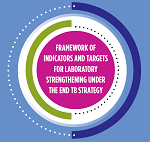
18 October 2016- The End TB Strategy calls for the early diagnosis of TB including universal drug-susceptibility testing (DST), and a prerequisite for any national TB programme to reach this goal is a quality-assured laboratory network equipped with rapid diagnostics. The newly published WHO Framework of indicators and targets for laboratory strengthening under the End TB Strategy, developed in collaboration with a team from the GLI core group, serves as a guide for all countries developing plans for laboratory strengthening during 2016-2025.
The 12 core indicators under the Framework measure programmes’ capacity to detect TB accurately and rapidly using new diagnostics, provide universal DST, and ensure the quality of testing. These indicators will be monitored globally by WHO as countries progress towards reaching the targets. The Framework also provides methods for calculating country-specific targets for the numbers of tests and facilities needed for each of the main diagnostic technologies. Given advancements in diagnostic technologies and the need for country-specific targets that consider epidemiology and issues of patient access, the previous global targets that were based on numbers of facilities relative to the general population (1 microscopy center per 100,000 population, 1 culture facility per 5 million population, etc.) are no longer recommended.
The Framework is available online at www.who.int/tb/publications/labindicators